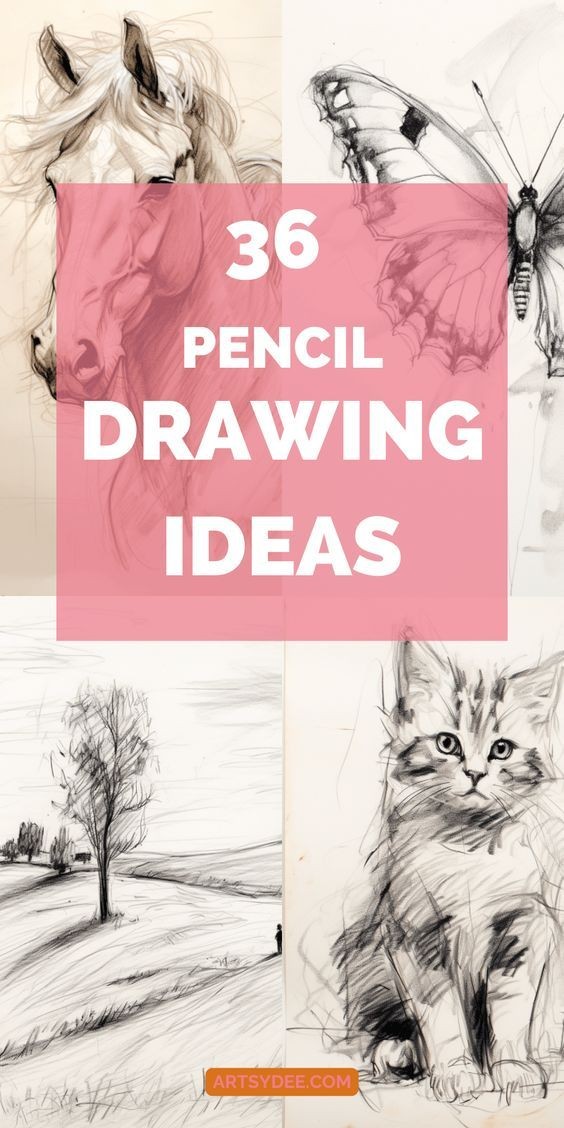The Secret Sauce to Perfect Pencil Sketches? Discover 36 Game-Changing Pencil Drawing Ideas!
If you’ve ever gazed at a stunning pencil sketch and wondered how to achieve such flawless detail and shading, you’re not alone. Mastering pencil drawing takes more than just practice; it requires understanding key techniques and exploring a variety of creative ideas. Whether you're a seasoned artist or just starting, this guide reveals the secrets to perfect pencil sketches and introduces 36 game-changing drawing ideas to elevate your craft.
1. Understanding Pencil Types and Their Uses
Choosing the right pencil can make a huge difference. Graphite pencils come in different hardness levels, from 9H (hard) to 9B (soft). Hard pencils are ideal for fine lines and detailed work, while soft pencils are perfect for rich, dark shading. Experiment with different types to find what works best for your style.
2. Mastering Basic Techniques
Hatching and Cross-Hatching: Use parallel lines to build up shading. Cross-hatching involves layering intersecting lines for deeper shadows.
Blending: Use a blending stump or your fingers to smooth out pencil strokes and create soft gradients.
Stippling: Create texture and shading by placing small dots closely together. This technique adds depth and dimension to your sketches.
3. Exploring Creative Pencil Drawing Ideas
Here are 36 drawing ideas to inspire your pencil sketching journey:
Botanical Illustrations: Sketch intricate details of flowers and leaves to practice texture and shading.
Portraits: Capture the essence of a person with realistic facial features and expressions.
Still Life: Arrange everyday objects and draw them from different angles to improve observation skills.
Animal Studies: Draw pets or wildlife to understand fur textures and dynamic poses.
Architectural Sketches: Create detailed drawings of buildings, bridges, and structures to refine your line work.
Fantasy Characters: Design mythical creatures or imaginative figures to experiment with proportions and creative elements.
Landscapes: Capture natural scenes like forests, mountains, and lakes to practice perspective and depth.
Abstract Patterns: Create geometric designs and patterns to explore shapes and shading techniques.
Fashion Illustrations: Sketch clothing and accessories to learn about fabric textures and folds.
Historical Figures: Draw famous personalities to understand historical styles and accurate portrayals.
Concept Art: Design environments or objects for games or movies to enhance your creative vision.
Children’s Book Illustrations: Develop whimsical characters and scenes for storytelling.
Self-Portraits: Challenge yourself to draw your own likeness and reflect on your artistic growth.
Movie Scenes: Recreate iconic moments from films to practice dynamic compositions.
Fantasy Landscapes: Imagine and draw otherworldly settings with unusual perspectives and details.
Scientific Illustrations: Depict anatomical structures or scientific specimens for precise detail.
Cultural Art: Explore art styles from different cultures and incorporate them into your sketches.
Emotional Expressions: Draw various facial expressions to convey different emotions and moods.
Street Scenes: Capture the energy of urban life with bustling cityscapes and lively crowds.
Music-Inspired Art: Create sketches inspired by your favorite songs or musical genres.
Vintage Objects: Sketch antiques or retro items to practice intricate detailing.
Surrealist Art: Experiment with dream-like and fantastical elements for a unique approach.
Comic Book Characters: Design dynamic heroes and villains with bold lines and dramatic poses.
Architectural Details: Focus on intricate elements like doors, windows, and moldings.
Sports Action Shots: Draw athletes in motion to capture dynamic movement and energy.
Seasonal Scenes: Create artwork inspired by different seasons, from snowy landscapes to sunny beaches.
Dreamscapes: Illustrate scenes from your dreams for a personal and imaginative touch.
Mythological Figures: Bring ancient myths to life with detailed and dramatic representations.
Minimalist Art: Embrace simplicity with clean lines and minimal shading.
Doodles and Sketches: Fill a sketchbook with random doodles to free your creativity.
Animal Portraits: Create lifelike portraits of animals with attention to detail.
Architectural Fantasies: Design imaginative buildings and structures with a creative twist.
Everyday Life: Draw common scenes from daily life to capture the beauty in the mundane.
Reflections: Practice drawing reflections in water or glass for an added challenge.
Fantasy Maps: Design imaginary worlds with detailed maps and cartographic elements.
Gesture Drawing: Focus on capturing the essence of a pose quickly to improve your figure drawing skills.
4. Building Your Sketching Routine
Consistency is key to improvement. Set aside dedicated time for sketching each day or week. Keep a sketchbook handy to jot down ideas, practice techniques, and track your progress. Don’t be afraid to experiment with new ideas and revisit old ones with a fresh perspective.
Conclusion
Perfecting pencil sketches involves mastering techniques, choosing the right tools, and exploring a diverse range of drawing ideas. With these 36 game-changing pencil drawing ideas, you can push the boundaries of your creativity and develop your unique artistic voice. Embrace the process, enjoy the journey, and let your sketches reflect your passion and skill.
By integrating these tips and ideas into your practice, you’ll uncover the secret sauce to creating stunning pencil sketches that captivate and inspire. Happy sketching!






